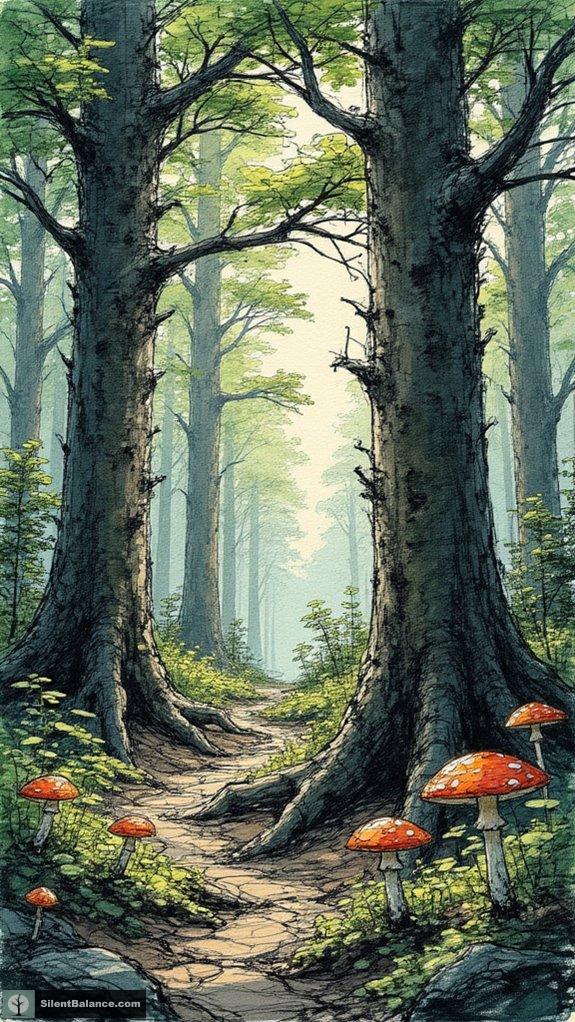The Forest’s Dance: Cooperation and Competition****
In the enchanting realm of forests, trees embody a dual nature—where cooperation and competition entwine like a winding vine.
I often marvel at mother trees, who, through their intricate root systems and partnership with fungi, share nourishment with their young. It’s a beautiful symbol of family bonds, akin to a caring tattoo artist delicately crafting their masterpiece. Yet, amidst this nurturing is an unyielding struggle for sunlight and resources—what a wild world! For more on this, visit our blog, Silent Balance, where we explore the symbolic relationships trees express.
One autumn day, I ventured into a forest that felt like a living organism. I stumbled upon two trees reaching toward the sky, attempting to overshadow one another. It struck me. Their struggle for light mirrored my own moments of competition in life. Yet, beneath that rivalry lay a deeper beauty—a reminder that cooperation is flourishing, just like the roots hidden underground.
Exploring this balance contrasts the fierce, yet heartfelt connections among trees. After all, in their silent way, they teach invaluable lessons about resilience and community.
Quick Takeaways
- Trees engage in cooperation by sharing resources via the Wood Wide Web, enhancing survival rates and community resilience.
- Mother trees prioritize support for related trees, fostering kinship networks for better resource allocation and stress response.
- Competition among trees for sunlight, water, and nutrients can lead to decreased growth rates and increased mortality in crowded forests.
- The balance between cooperation and competition is essential for maintaining healthy and resilient forest ecosystems.
- Collective behavior among tree networks allows for biodiversity, with trees supporting neighbors even amid competitive pressures to enhance overall ecosystem strength.
The Role of Mother Trees in Forest Communication
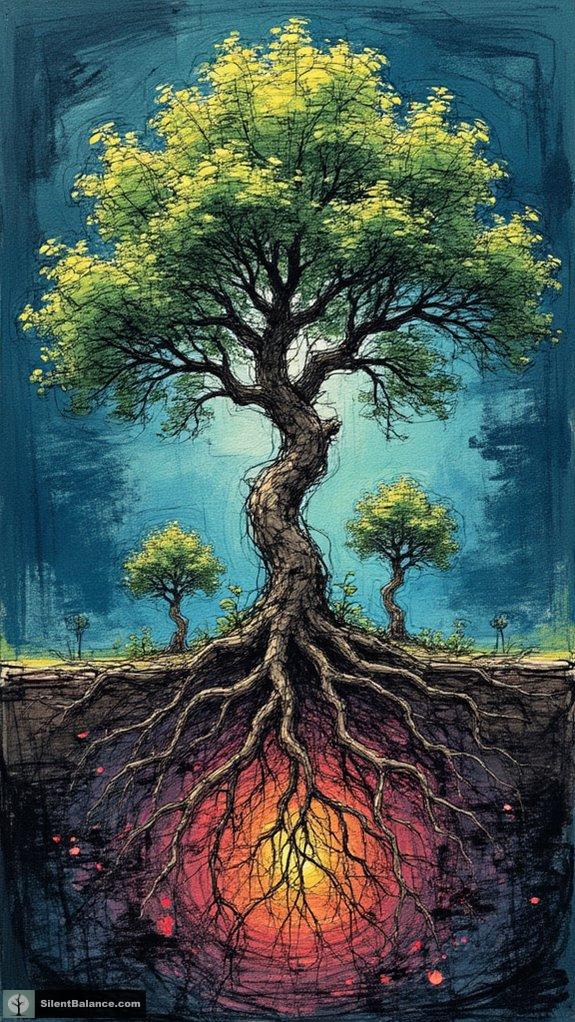
Ever wondered how trees chat with each other? Envision this: beneath the forest floor, a bustling underground network thrives, connecting mother trees to their neighbors.
These ancient giants harness mycorrhizal fungi, forming a Wood Wide Web that lets them share essential resources like carbon and water. Mycelium facilitates the transfer of water, nitrogen, carbon, and minerals among trees. This cooperative network also contributes to soil health, allowing trees to thrive together in symbiosis.
Imagine being a stressed sapling, and suddenly, a mother tree sends you nutrient love, just when you need it.
Picture a struggling sapling receiving a timely boost of nutrients from a caring mother tree, just when hope seems lost.
That’s some serious tree-to-tree communication!
These mother trees even send out chemical signals, like an eco-friendly text message, alerting nearby trees of pests or dangers.
They’re not just nurturing but also strategists, recognizing their kin and prioritizing their support.
In this leafy domain, cooperation isn’t just wise; it’s survival.
Who knew trees had such social lives?
Understanding Competitive Dynamics in Tree Networks

When you dig into the competitive dynamics of tree networks, you realize there’s more than just a serene canopy overhead—there’s a high-stakes game happening beneath the surface.
Trees aren’t just hanging out; they’re jockeying for position as they compete for sunlight, water, and nutrients. This intense competition shapes who thrives and who’s left in the dust. It’s like a tattoo showdown where only the bold survive. In this underground battle, mother trees often play a crucial role as they support neighboring trees through resource sharing.
You might be wondering, how does this affect biodiversity?
Well, networks that nail the balance between competition and cooperation foster stunning diversity. It creates a complex ecosystem where weaker players can keep competing with stronger ones—similar to an underdog story in sports! Collective behavior in these tree networks contributes to the intricate relationships that help maintain ecological balance.
Mechanisms of Cooperation Among Tree Species
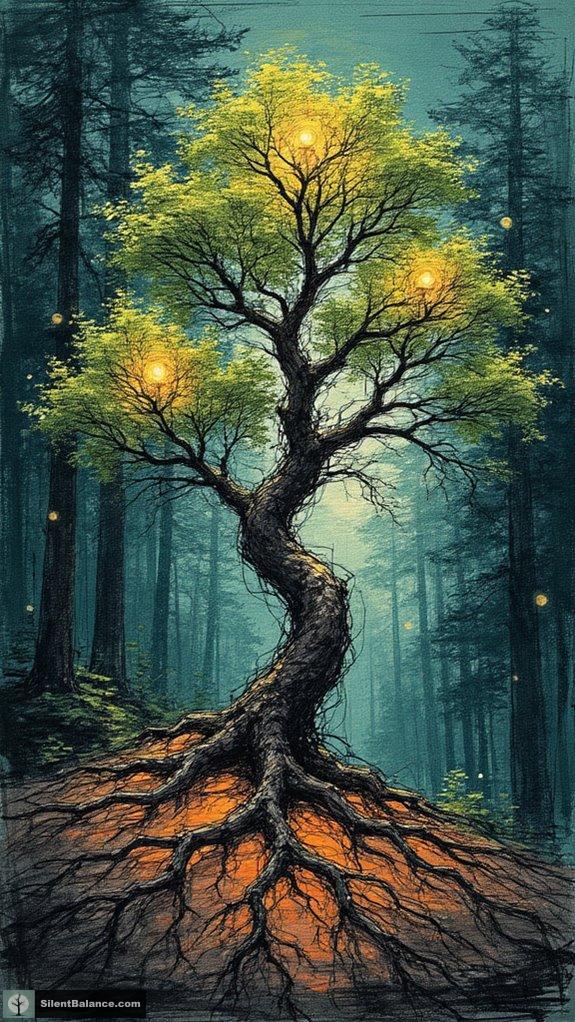
As you dive deeper into the forest’s underground territory, you’ll find that cooperation among tree species isn’t just a nice idea—it’s an essential lifeline for many.
Picture this: mycorrhizal fungi acting like Mother Nature’s social media, linking tree roots and facilitating resource sharing. Trees like Douglas firs and paper birches swap carbon and nutrients through these fungal networks, ensuring even the smallest saplings get a boost. These fungi enhance trees’ ability to absorb water and nutrients, while trees provide carbohydrates to fungi, creating a mutually beneficial relationship.
You’d be amazed to learn that trees can recognize kin, showing favoritism that boosts survival rates. It’s like a family reunion, but for trees!
And when it comes to stress, they’re chatty too—communicating potential threats to their neighbors.
Cultural Symbolism of Tree Communication
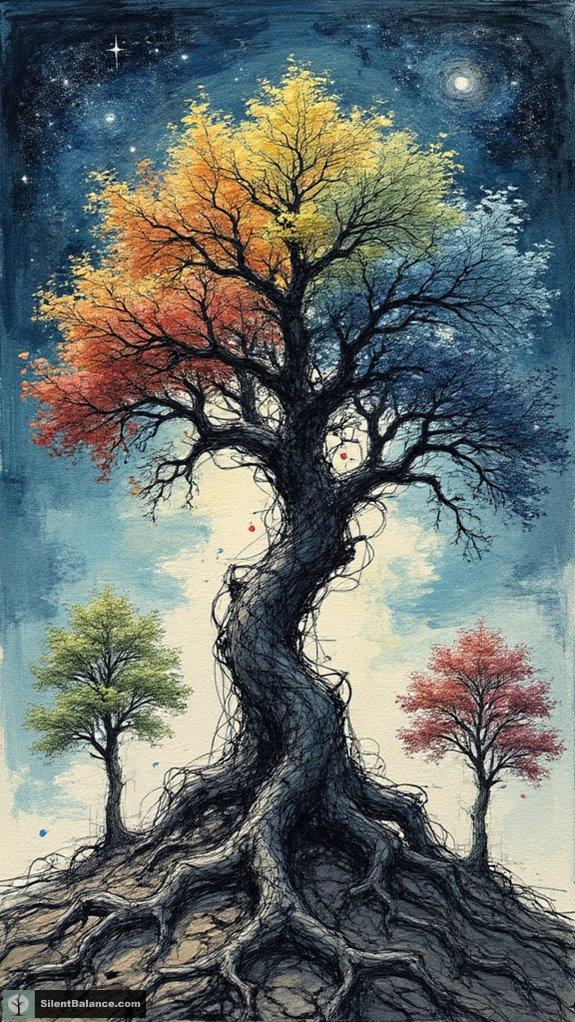
In the grand tapestry of cultural symbolism, trees hold a special place as communicators that connect us to deeper meanings and spiritual dimensions.
Ever thought about how the Tree of Life embodies cosmic order? It’s like a bridge between the earthly and divine! From Turkish myths to Celtic tales, trees symbolize balance and renewal, acting as life’s heartbeat.
Imagine an Aspen whispering secrets from ancestors or an Oak brimming with wisdom. These trees don’t just stand around; they channel messages packed with meaning and unity. Furthermore, the Tree of Life in Turkish mythology stands at the center of the universe, representing continuity of life and cosmic order.
They’re more than just branches and leaves; they’ve got stories.
Impacts of Competition on Forest Ecosystems

Competition in forest ecosystems shapes the lives of trees in profound ways, affecting their growth, health, and even survival. You mightn’t realize it, but that towering tree next to you is in a battle for its life, locked in a competitive dance with its neighbors. In some old-growth forests, trees face stifling competition, often leading to increased mortality rates. Trees that died were often in more competitive environments than survivors, highlighting the impact of competition on mortality.
And it’s not just about life and death; competition slashes growth rates, too. Did you know a 20-cm diameter tree in the Amazon could see a whopping 34% growth decrease? Yikes! Trees in crowded spaces struggle to adjust to changing climates, making their survival even trickier.
Future Research Directions in Tree Networks
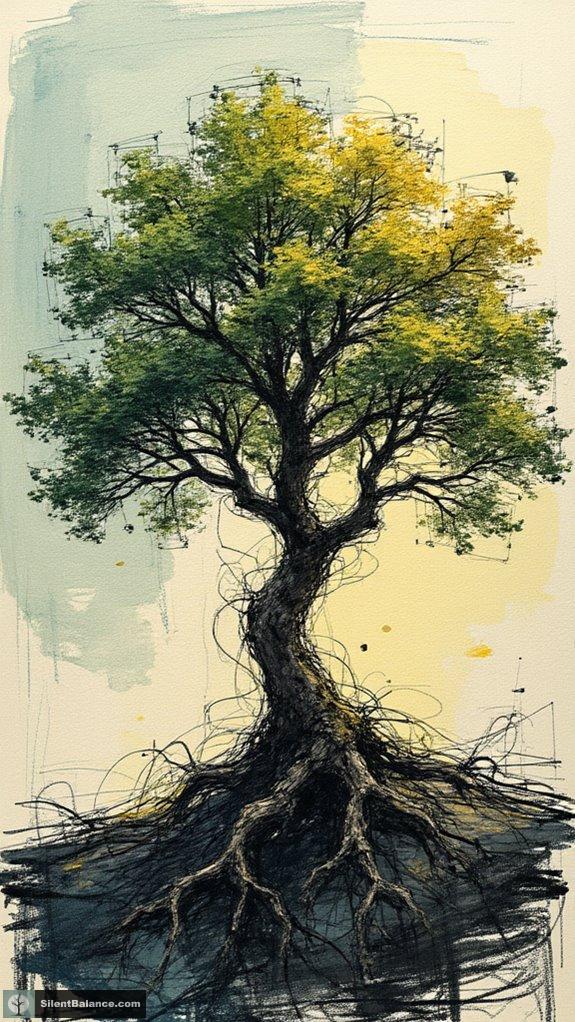
With the complexity of tree networks buzzing like a live tattoo convention, future research in this field promises to reveal some intriguing viewpoints.
You may want to keep an eye on these exciting directions:
- TreeDivNet Expansion – Linking biodiversity with growth and survival across global terrains is in the works!
- Recursive Models – Developing algorithms to simulate tree structure and resource allocation could rock the ecological world, right?
- Mycorrhizal Mysteries – Understanding how mycorrhizal networks help trees share nutrients opens doors to cooperative strategies.
- Age-Specific Models – Creating dynamic networks that adapt with changing conditions—like aging forests—could redefine how we perceive tree interactions!
Balancing Competition and Cooperation in Forest Management

Steering the blend of competition and cooperation in forest management is a bit like getting the perfect tattoo—it’s all about finding that sweet spot where creativity meets technique.
You’ve got to tap into the benefits of teamwork while juggling a bit of healthy competition, right? Sharing resources can cut costs and boost efficiency, but guess what? Unequal structures can mess with smooth sailing.
Check out this quick table to visualize key dynamics:
| Benefits of Cooperation | Challenges | Solutions |
|---|---|---|
| Cost savings | Unequal competitive structures | Transparent fees |
| Shared services | Declining support services | Strong partnerships |
| Better negotiation power | Uncertainties from services | Local expert input |
Finding the balance isn’t just smart—it’s essential for keeping those forests thriving.
Cultural Symbolism of Tree Communication
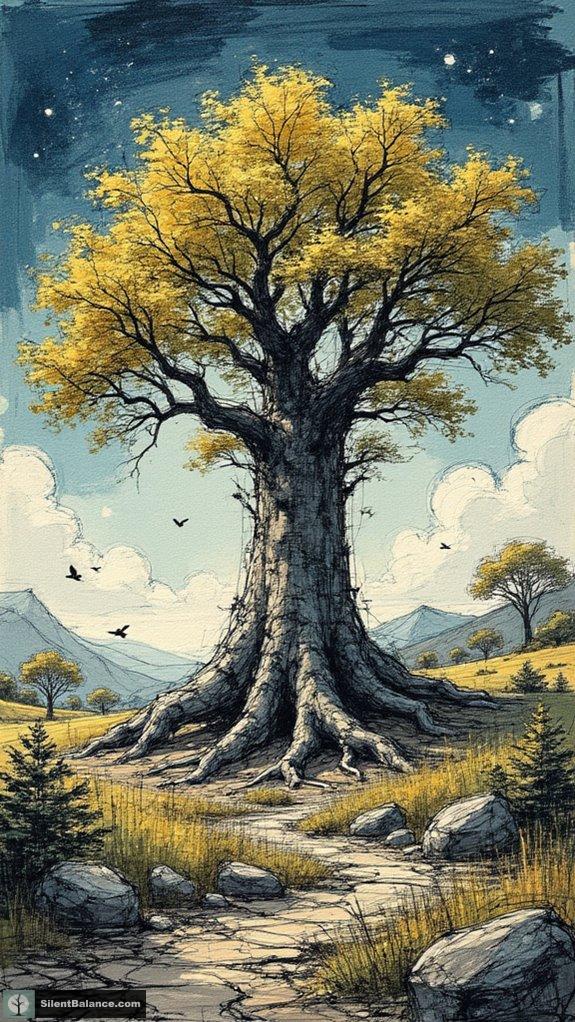
When you think about trees, do you see more than just their bark and leaves?
Trees are cultural icons woven into our myths and folklore, telling stories of life, growth, and renewal that echo through time.
From the sacred Aspen that whispers ancestral messages to the mighty Baobab that stands as a community’s heartbeat, their symbolism in art and beyond enriches our connection to nature in ways we often overlook.
Trees as Cultural Icons
Trees have long stood as cultural icons, representing far more than just trunks and leaves—they embody deep spiritual connections, cycles of life, and rich artistic inspiration.
Whether you’re an art lover or simply appreciate nature’s beauty, consider how trees resonate with us:
- Spiritual Bridges: They connect us to the divine, acting as a link between human experiences and the universe.
- Cycles of Life: Think of the Tree of Life, representing continual rebirth and growth—a timeless symbol.
- Artistic Muse: Artists draw inspiration from trees, crafting masterpieces that reflect harmony and unity.
- Cultural Narratives: Trees weave through stories, connecting generations—like family trees that embody kinship, resilience, and strength.
Isn’t it amazing how these giants shape our understanding of life itself?
Myths and Folklore
Picture wandering through a mystical forest where the trees aren’t just silent witnesses but actual storytellers, whispering ancient tales only to those who truly listen.
In cultures worldwide, trees have been revered as wise beings, acting as conduits for divine knowledge.
Check out this table showcasing some fascinating stories:
| Culture | Tree Story |
|---|---|
| Irish Folklore | Elder Oak memorializes druidic wisdom |
| Greek Mythology | Dodona oak speaks prophetic truths |
| Persian Epics | Alexander meets a talking tree |
| Indian Mythology | Sun and Moon trees share prophecies |
These tales highlight the deep-rooted belief in trees as guardians of history. Isn’t it exciting to envision their whispers carrying secrets from the past?
Symbolism in Art
Exploring the world of trees in art reveals a vibrant tapestry woven with deep meanings and connections to our human experience.
Trees speak a language that transcends time and culture. Here are four powerful symbols you might find intriguing:
- Axis Mundi: Trees connect earth to the divine, serving as sacred portals between dimensions.
- Tree of Life: A staple in art, representing resilience, growth, and the cycles inherent in all living things.
- Spiritual Guardians: Trees embody strength and protection, reminding us of our connection to each other and nature.
- Cultural Messengers: From ancient scripts to modern canvases, trees convey wisdom and inspire creativity, fueling our relentless pursuit of understanding.
Symbolism of Cooperation and Competition in Tree Networks

While you may think of forests as collections of solitary trees competing for sunlight and resources, the reality is far more complex and collaborative. Trees engage in both competition and cooperation, forming vibrant networks that challenge traditional ideas.
| Cooperation | Competition |
|---|---|
| Kin recognition | Resource allocation |
| Interconnected growth | Light and nutrient struggle |
| Warning systems | Survival of the fittest |
| Superorganism concept | Individual isolation |
| Collective defense | Fractured ecosystems |
These “mother trees” nurture their kin, showcasing a profound sense of community. By sharing resources through underground networks, trees evolve from mere individuals to crucial players in sustaining a resilient ecosystem. Isn’t it fascinating how connections shape survival in the wild?
Questions and Answers
How Do Tree Species Adapt to Changing Competitive Environments?
When you think about how tree species adapt to changing competition, it’s like watching a crew of artists in a jam session.
They flex their growth based on their surroundings, dropping roots where they can snag light and moisture. Some species, like that fierce tattoo artist, crank out fast growth to dominate, while others balance out defense against pests.
Isn’t nature’s ink work amazing? Adaptation’s their game, and they’re always hustling for survival!
What Role Do Fungi Play in Tree Cooperation?
Fungi are the unsung heroes of tree cooperation, dude!
These mycelium mavericks stretch their filaments all through the soil, connecting trees and helping them swap nutrients like pros in a tattoo shop trading ink tips.
You’ve got your “mother trees” as the OGs, sharing resources with younger saplings.
They even send distress signals, just like friends looking out for each other.
Without these fungal networks, it’d be a rough road for forest life!
How Does Climate Change Affect Tree Competition?
Climate change shakes up tree competition big time! Rising temps crank up water demands, which stress trees out.
You might see some species flexing their photosynthesis skills thanks to elevated CO2, but watch out—heat stress can hit hard.
If trees can’t compete for water and light, their growth takes a nosedive, making forests more vulnerable.
Can Urban Forests Display Cooperation and Competition?
Absolutely, urban forests can totally showcase both cooperation and competition!
You’ve got stakeholders, like the city and private landowners, working together to boost green spaces while sometimes clashing over land use.
Picture it: a utility company needing to trim trees for power lines—that’s competition!
But when these groups join forces for tree canopies or stormwater management, that’s pure cooperation.
It’s all about striking that sweet balance for our urban jungles to thrive!
How Do Human Activities Influence Forest Interaction Dynamics?
Human activities totally shake up forest dynamics, right?
With all the land-use changes buzzin’ around, you’re seeing connectivity take a hit, making it tough for species to vibe together.
Think about deforestation and urban sprawl splittin’ habitats—species just can’t jam like they used to.
Plus, over-extraction strains resources, turning peaceful cohabitation into a scramble for survival.
Summary
In the elaborate dance of forest networks, trees don’t just stand tall; they communicate, collaborate, and compete like members of a tight-knit community. Isn’t it fascinating how the giants among them, the Mother Trees, orchestrate this complex symphony? As we explore deeper into their world, let’s recall: cooperation fuels survival, while competition shapes diversity. So, how can we foster this balance in our own ecosystems? Together, we can keep nature’s graffiti—lush and vibrant—alive for generations to come.
References
- https://insider.si.edu/2016/01/trees-employ-similar-strategies-outcompete-neighbors/
- https://www.e3s-conferences.org/articles/e3sconf/pdf/2024/08/e3sconf_gesd2024_01015.pdf
- https://www.sugiproject.com/blog/forests-are-social
- https://www.jstor.org/stable/42609207
- https://fwcs.oregonstate.edu/sites/agscid7/files/fw/eecb_fall_2022.pdf
- https://mothertreeproject.org/about-mother-trees/
- https://www.nationalforests.org/blog/underground-mycorrhizal-network
- https://bioneers.org/finding-the-mother-tree-ze0z2105/
- https://www.ttbook.org/interview/listening-mother-trees
- https://www.youtube.com/watch?v=ydbzrun3opk
- https://www.pnas.org/doi/10.1073/pnas.1712211114
- https://link.aps.org/doi/10.1103/ynwt-7g91
- https://esajournals.onlinelibrary.wiley.com/doi/10.1002/ecs2.4807
- https://www.e3s-conferences.org/articles/e3sconf/abs/2024/08/e3sconf_gesd2024_01015/e3sconf_gesd2024_01015.html
- https://www.ecomatcher.com/understanding-the-wood-wide-web/
- https://one-more-tree.org/blog/2025/04/04/what-do-trees-say-to-the-world-plant-communication-through-underground-mycorrhizal-networks/
- https://www.nature.com/articles/s41598-020-70052-8
- https://www.ufz.de/index.php?en=36336&webc_pm=07/2025
- https://esajournals.onlinelibrary.wiley.com/doi/10.1002/ecs2.1903
- https://cembotanik.com/en/tree-mythologies
- 9 Minimalist DIY Branch Art Ideas - October 29, 2025
- 15 Best Twig Cluster Décor Ideas For Walls - October 28, 2025
- 10 Tree Silhouette Wall Art Ideas - October 28, 2025

